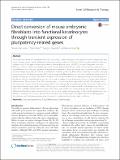Direct conversion of mouse embryonic fibroblasts into functional keratinocytes through transient expression of pluripotency-related genes
Author(s)
Iacovides, Demetris; Rizki, Gizem; Lapathitis, Georgios; Strati, Katerina
Download13287_2016_Article_357.pdf (2.033Mb)
PUBLISHER_CC
Publisher with Creative Commons License
Creative Commons Attribution
Terms of use
Metadata
Show full item recordAbstract
The insufficient ability of specialized cells such as neurons, cardiac myocytes, and epidermal cells to regenerate after tissue damage poses a great challenge to treat devastating injuries and ailments. Recent studies demonstrated that a diverse array of cell types can be directly derived from embryonic stem cells (ESCs), induced pluripotent stem cells (iPSCs), or somatic cells by combinations of specific factors. The use of iPSCs and direct somatic cell fate conversion, or transdifferentiation, holds great promise for regenerative medicine as these techniques may circumvent obstacles related to immunological rejection and ethical considerations. However, producing iPSC-derived keratinocytes requires a lengthy two-step process of initially generating iPSCs and subsequently differentiating into skin cells, thereby elevating the risk of cellular damage accumulation and tumor formation. In this study, we describe the reprogramming of mouse embryonic fibroblasts into functional keratinocytes via the transient expression of pluripotency factors coupled with directed differentiation. The isolation of an iPSC intermediate is dispensable when using this method. Cells derived with this approach, termed induced keratinocytes (iKCs), morphologically resemble primary keratinocytes. Furthermore they express keratinocyte-specific markers, downregulate mesenchymal markers as well as the pluripotency factors Oct4, Sox2, and Klf4, and they show important functional characteristics of primary keratinocytes. iKCs can be further differentiated by high calcium administration in vitro and are capable of regenerating a fully stratified epidermis in vivo. Efficient conversion of somatic cells into keratinocytes could have important implications for studying genetic skin diseases and designing regenerative therapies to ameliorate devastating skin conditions.
Date issued
2016-07Department
Massachusetts Institute of Technology. Department of BiologyJournal
Stem Cell Research & Therapy
Publisher
BioMed Central
Citation
Iacovides, Demetris, Gizem Rizki, Georgios Lapathitis, and Katerina Strati. "Direct conversion of mouse embryonic fibroblasts into functional keratinocytes through transient expression of pluripotency-related genes." Stem Cell Research & Therapy. 2016 Jul 29;7(1):98.
Version: Final published version
ISSN
1757-6512